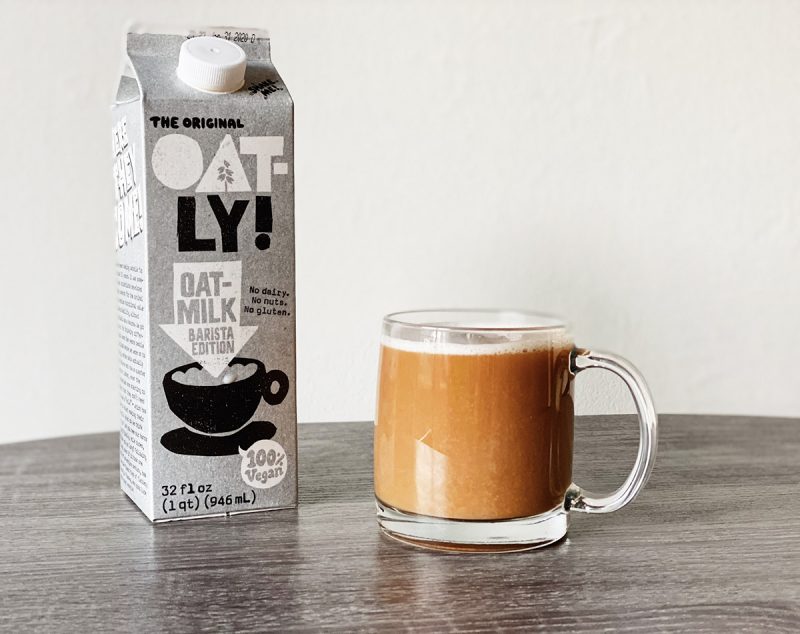Last Saturday (22nd August) was was World Plant Milk Day and a new campaign urging dairy milk consumers to try plant based milks for seven days. Anyway, it prompted me to write about our plant based milk journey!
Since writing this article we have since found out Oatly have taken investment from Blackstone, who are linked with forcing people out of their homes and profiting from the burning of the Amazon rainforest. As such – we will be switching to another oat milk!
This post contains affiliate links to products that I have used or recommend. I have made these as unobtrusive as possible. You can learn more about what these do here.
Why use plant based milk?

The main reason we first broached the idea of switching to plant based milks was to reduce our environmental impact. As much as we all love cows, they use a whole heap of resources in terms of land and water. And what they create unfortunately has a high impact on acidification and eutrophication (waterways too rich in nutrients). Plants typically use less for comparable gain. Take a look at this graphic from the BBC showing data from the Poore & Nemecek research article (2018). Oat milk has the overall lowest emission, land use, and water use. Almond falls down only because of the water use.
Dairy-alternative milks tend to have fewer calories, less fat (except for coconut-based milk), more water content (for better hydration), less protein (except soy). Some are fortified with other vitamins and nutrients.
nutrition.org
By switching to plant based milks you can reduce the environmental impact dramatically. But of course, there is also the taste factor. Whatever you switch to you have to like it!
What tastes best?
Our initial foray we tried soy, oat and almond. We tried each one how we would normally use milk – as a drink, in tea, in coffee, and in cereal.
| Use | Dairy Milk | Soy Milk | Almond Milk | Oat Milk |
|---|---|---|---|---|
| Drink | ✔ | ✘ | ✔ | ✔ |
| Tea | ✔ | ✘ | ✔ | ✔ |
| Coffee | ✔ | ✔ | ✔/✘ | ✘ |
| Cereal | ✔ | ✔ | ✔ | ✔ |
Taste wise we found unsweetened almond milk was winning out, although we found it could be weird on coffee (sort of going bitty?) but other than that was fine. So we went with that for about a year. We didn’t miss dairy milk at all! Unfortunately – as I mentioned in my Green Guilt article – we then found out almond milk was bad for bees!
Back to the taste test
Over the year we were using almond milk a few of the brands that to plant based milks started releasing “barista” milks that are specially formulated for frothy coffees. Before these plant based milks weren’t great at the froth!
| Use | Dairy Milk | Soy Milk | Almond Milk | Oat Milk | Barista Oat |
|---|---|---|---|---|---|
| Drink | ✔ | ✘ | ✔ | ✔ | ✔ |
| Tea | ✔ | ✘ | ✔ | ✔ | ✔ |
| Coffee | ✔ | ✔ | ✔/✘ | ✘ | ✔ |
| Cereal | ✔ | ✔ | ✔ | ✔ | ✔ |
We have a winner!
After a month of using Barista oat milk we are super happy that we now have a milk that has less of an impact and tastes great. It does cost a fair bit more per litre than moo-juice, which is inevitable when dairy farmers have been exploited and under-payed for years. Dairy as it is now, is unsustainable both economically and environmentally. We haven’t even touched on ethics.
That price difference highlights just how linked environmental issues are with equality issues. That extra cost is a huge difference for a lot of people. However, that has not stopped an increase in the number of people using plant based milks, now 23%, up from 19% the previous year. Even if people haven’t switch we’re drinking 50% less dairy milk in general.
The downsides
With all farming, there is a risk to biodiversity. Whether that is through deforestation to grow soy or the fertilisers, pesticides and weedkillers used to create a monoculture of one crop that inevitably run off with soil erosion.
We have lost 97% of species rich meadows through agriculture which could be cut and used as animal feed and grazed while keeping that biodiversity.
In some ways cattle have the upper hand when it comes to the environment. Cattle can encourage biodiversity through their grazing and trampling areas, and are a key component in rewilding projects because of that.
Poor pay and less demand can mean dairy farmers going out of business. This is somebodies livelihood and as much as using less dairy is great for the environment, there is that other side. It would be great to see more schemes like the company Hälsa introduced in America, where they help dairy farmers switch to growing oats, here in the UK.
Would you recommend plant based milks?
Absolutely! They are far better for the environment – not perfect but they are so much better. And those imperfections are part of the process of becoming greener as a global society. You can make that small greener step right now. And that will start to drive the change. Definitely give barista oat milks a go, especially if you are coming from dairy, it’s much closer to what you will be used to.
Maybe head to https://www.worldplantmilkday.com/ and make a pledge to try it for 7 days and let us know how you get on in the comments!
Do you use a plant based milk? What do you use, and how did you choose?
Let us know in the comments below!

1 thought on “Our plant based milk journey”